(3+2)-Cycloadditions of Levoglucosenone (LGO) with Fluorinated Nitrile Imines Derived from Trifluoroacetonitrile: An Experimental and Computational Study †
Abstract
:1. Introduction
2. Results and Discussion
2.1. Experimental Study
2.2. Computational Study
Mechanistic Investigations by DFT Calculations
3. Materials and Methods
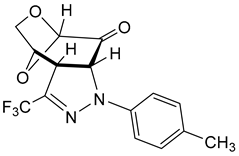
- 5-(p-Tolyl)-3-(trifluoromethyl)-9,11-dioxa-4,5-diazatricyclo[6.2.1.02,6]undec-3-en-7-one (exo-11a). Yield: 175 mg (54%), pale-yellow crystals, mp = 132–133 °C (petroleum ether/CH2Cl2). [α]D20 = –629 (c 0.3, CHCl3).
- 1H NMR (CDCl3): δ 2.34 (s, 3H, CH3); 4.01 (d, JH,H = 12.2 Hz, 1H); 4.07–4.09 (m, 1H); 4.12–4.14 (m, 1H); 5.15 (d, JH,H = 4.7 Hz, 1H); 5.24 (d, JH,H = 12.1 Hz, 1H); 5.28 (s, 1H); 7.09, 7.13 (AB-system, JH,H = 8.5 Hz, 4CHarom);
- 13C NMR (CDCl3): δ 21.1, 51.8, 63.6, 70.9, 100.2, 68.6, 114.5, 129.9, 120.9 (q, 1JC,F = 277.7 Hz, CF3); 131.6, 140.7, 134.0 (q, 2JC,F = 36.9 Hz, C–CF3), 194.5 (C=O);
- 19F NMR: δ –63.9;
- IR: ν 1703s (C=O), 1510s, 1378m, 1299m, 1258s, 1193m, 1123vs, 1083s, 943m, 801s, cm−1;
- EA for C15H13F3N2O3 (326.28): calcd. C 55.22, H 4.02, N 8.59; found C 55.03, H 4.04, N 8.85.
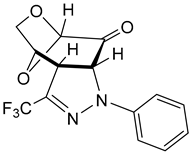
- 5-Phenyl-3-(trifluoromethyl)-9,11-dioxa-4,5-diazatricyclo[6.2.1.02,6]undec-3-en-7-one (exo-11b). Yield: 190 mg (61%), pale yellow crystals, mp = 108–109 °C (petroleum ether/CH2Cl2). [α]D20 = –515 (c 0.3, CHCl3).
- 1H NMR (CDCl3): δ 3.96 (dd, JH,H = 12.0 Hz, JH,H = 1.0 Hz, 1H); 4.04–4.07 (m, 1H); 4.09–4.10 (m, 1H); 5.13 (d, JH,H = 2.3 Hz, 1H); 5.24 (d, JH,H = 11.9 Hz, 1H); 5.26 (s, 1H); 7.00–7.03 (m, 1CHarom); 7.17–7.20 (m, 2CHarom); 7.30–7.34 (m, 2CHarom);
- 13C NMR: δ 51.6, 63.2, 71.1, 100.4, 68.5, 114.4, 121.9, 129.2, 120.8 (q, 1JC,F = 268.1 Hz, CF3); 134.8 (q, 2JC,F = 37.3 Hz, C–CF3); 142.9, 194.6 (C=O).
- 19F NMR (CDCl3): δ –64.0;
- IR: ν 1744s (C=O), 1600s, 1494s, 1312s, 1297m, 1259s, 1185s, 1092vs, 976s, 913s, 799s, 752s, cm−1;
- EA for C14H11F3N2O3 (326.28): calcd. C 53.85, H 3.55, N 8.97; found C 53.78, H 3.54, N 9.22.
4. Conclusions
Supplementary Materials
Author Contributions
Funding
Institutional Review Board Statement
Informed Consent Statement
Data Availability Statement
Acknowledgments
Conflicts of Interest
References
- Huisgen, R. 1,3-Dipolar Cycloadditions: Past and Future. Angew. Chem. Int. Ed. Engl. 1963, 2, 565–598. [Google Scholar] [CrossRef]
- Fišera, L.; Huisgen, R.; Kalwinsch, I.; Langhals, E.; Li, X.; Mloston, G.; Polborn, K.; Rapp, J.; Sicking, W.; Sustmann, R. New thione chemistry. Pure Appl. Chem. 1996, 68, 789–798. [Google Scholar] [CrossRef]
- Ríos-Gutiérrez, R.; Domingo, L.R. Unravelling the Mysteries of the [3+2] Cycloaddition Reactions. Eur. J. Org. Chem. 2019, 2019, 267–282. [Google Scholar] [CrossRef]
- Breugst, M.; Reissig, H.-U. The Huisgen Reaction: Milestones of the 1,3-Dipolar Cycloaddition. Angew. Chem. Int. Ed. 2020, 59, 12293–12307. [Google Scholar] [CrossRef]
- Jamieson, C.; Livingstone, K. (Eds.) The Nitrile Imine 1,3-Dipoles: Properties, Reactivity and Applications; Springer International Publishing: Berlin/Heidelberg, Germany, 2020. [Google Scholar]
- Sharp, J.T. Nitrile Ylides and Nitrile Imines. In Synthetic Applications of 1,3-dipolar Cycloaddition Chemistry toward Heterocycles and Natural Products; Padwa, A., Pearson, W.H., Eds.; Wiley: New York, NY, USA, 2020; Chapter 7; pp. 473–538. [Google Scholar]
- Deepthi, A.; Acharjee, N.; Sruthi, S.L.; Meenakshy, C.B. An overview of nitrile imine based [3+2] cycloadditions over half a decade. Tetrahedron 2022, 116, 132812. [Google Scholar] [CrossRef]
- Matiadis, D. Strategies and Methods for the Synthesis of 2-Pyrazolines: Recent Developments (2012–2022). Adv. Synth. Catal. 2023, 365, 1934–1969. [Google Scholar] [CrossRef]
- Ren, Y.; Ma, R.; Yang, F.; Wang, K.-H.; Wang, J.; Huang, D.; Lv, X.; Hu, Y. Synthesis of Difluoromethyl Pyrazolines and Pyrazoles by [3+2] Cycloaddition Reaction of Difluoroacetohydrazonoyl Bromides with Electron-deficient Olefins. Asian J. Org. Chem. 2022, 11, e202200438. [Google Scholar] [CrossRef]
- Li, M.-M.; Huang, H.; Tian, W.; Pu, Y.; Zhang, C.; Yang, J.; Ren, Q.; Tao, F.; Deng, Y.; Lu, J.; et al. Construction of multi-substituted pyrazoles via potassium carbonate-mediated [3+2] cycloaddition of in situ generated nitrile imines with cinnamic aldehydes. RSC Adv. 2022, 12, 13087–13092. [Google Scholar] [CrossRef]
- Rouatbi, F.; Mhiri, C.; Askri, M.; Knorr, M.; Rousselin, Y.; Kubicki, M.M. Regioselective Synthesis of Mono- and Dispiropyrazoline Derivatives via 1,3-dipolar Cycloaddition with Nitrilimines. J. Heterocycl. Chem. 2017, 54, 1152–1160. [Google Scholar] [CrossRef]
- Kowalczyk, A.; Utecht-Jarzyńska, G.; Mlostoń, G.; Jasiński, M. Trifluoromethylated pyrazoles via sequential (3+2)-cycloaddition of fluorinated nitrile imines with chalcones and solvent-dependent deacylative oxidation reaction. Org. Lett. 2022, 24, 2499–2503. [Google Scholar] [CrossRef]
- Utecht, G.; Mlostoń, G.; Jasiński, M. A straightforward access to trifluoromethylated spirobipyrazolines through a double (3+2)-cycloaddition of fluorinated nitrile imines with alkoxyallenes. Synlett 2018, 29, 1753–1758. [Google Scholar] [CrossRef]
- Mlostoń, G.; Grzelak, G.; Utecht, G.; Jasiński, M. First [3+2]-cycloadditions of thiochalcones as C=S dipolarophiles in reactions with fluorinated nitrile imines. Synthesis 2017, 49, 2129–2137. [Google Scholar] [CrossRef]
- Mlostoń, G.; Urbaniak, K.; Utecht, G.; Lentz, D.; Jasiński, M. Trifluoromethylated 2,3-dihydro-1,3,4-thiadiazoles via the regioselective (3+2)-cycloadditions of fluorinated nitrile imines with aryl, hetaryl, and ferrocenyl thioketones. J. Fluorine Chem. 2016, 192, 147–154. [Google Scholar] [CrossRef]
- Utecht, G.; Sioma, J.; Jasiński, M.; Mlostoń, G. Expected and unexpected results in reactions of fluorinated nitrile imines with (cyclo)aliphatic thioketones. J. Fluor. Chem. 2017, 201, 68–75. [Google Scholar] [CrossRef]
- Utecht-Jarzyńska, G.; Mykhaylychenko, S.S.; Rusanov, E.B.; Shermolovich, Y.G.; Jasiński, M.; Mlostoń, G. Highly fluorinated 2,3-dihydro-1,3,4-thiadiazole derivatives via (3+2)-cycloadditions of fluorinated, tertiary thioamides with nitrile imines derived from trifluoroacetonitrile. J. Fluor. Chem. 2021, 242, e109702. [Google Scholar] [CrossRef]
- Zhang, N.; Ma, H.; Cheung, C.W.; Zhang, F.-G.; Jasiński, M.; Ma, J.-A.; Nie, J. Regioselective [3 + 2] cycloaddition of di/trifluoromethylated hydrazonoyl chlorides with fluorinated nitroalkenes: A facile access to 3-di/trifluoroalkyl-5-fluoropyrazoles. Org. Biomol. Chem. 2023, 21, 5040–5045. [Google Scholar] [CrossRef] [PubMed]
- Cen, K.; Wei, J.; Feng, Y.; Liu, Y.; Wang, X.; Liu, Y.; Yin, Y.; Yu, J.; Wang, D.; Cai, J. Synthesis of fused 3-trifluoromethyl-1,2,4-triazoles via base-promoted [3 + 2] cycloaddition of nitrile imines and 1H-benzo[d]imidazole-2-thiols. Org. Biomol. Chem. 2023, 21, 7095–7099. [Google Scholar] [CrossRef]
- Tsuchiya, Y.; Sumi, K. Thermal Decomposition Products of Cellulose. J. Appl. Polym. Sci. 1970, 14, 2003–2013. [Google Scholar] [CrossRef]
- Zhang, H.; Meng, X.; Liu, C.; Wang, Y.; Xiao, R. Selective low-temperature pyrolysis of microcrystalline cellulose to produce levoglucosan and levoglucosenone in a fixed bed reactor. Fuel Process. Technol. 2017, 167, 484–490. [Google Scholar] [CrossRef]
- Xu, F.; Luo, J.; Jiang, L.; Zhao, Z. Improved production of levoglucosan and levoglucosenonefrom acid-impregnated cellulose via fast pyrolysis. Cellulose 2022, 29, 1463–1472. [Google Scholar] [CrossRef]
- Witczak, Z.J. (Ed.) Levoglucosenone and Levoglucosans: Chemistry and Applications; ATL Press, Inc. Science Publishers: Mount Prospect, IL, USA, 1994. [Google Scholar]
- Sarotti, A.M.; Zanardi, M.M.; Spanevello, R.A. Recent Applications of Levoglucosenone as Chiral Synthon. Curr. Org. Synth. 2012, 9, 439–459. [Google Scholar] [CrossRef]
- Comba, M.B.; Tsai, Y.; Sarotti, A.M.; Mangione, M.I.; Suárez, A.G.; Spanevello, R.A. Levoglucosenone and Its New Applications: Valorization of Cellulose Residues. Eur. J. Org. Chem. 2018, 5, 590–604. [Google Scholar] [CrossRef]
- Liu, X.; Carr, P.; Gardiner, M.G.; Banwell, M.G.; Elbanna, A.H.; Khalil, Z.G.; Capon, R.J. Levoglucosenone and Its Pseudoenantiomer iso-Levoglucosenone as Scaffolds for Drug Discovery and Development. ACS Omega 2020, 5, 13926–13939. [Google Scholar] [CrossRef] [PubMed]
- Camp, J.E.; Greatrex, B.W. Levoglucosenone: Levoglucosenone: Bio-Based Platform for Drug Discovery. Front. Chem. 2022, 10, e902239. [Google Scholar] [CrossRef] [PubMed]
- Warne, C.M.; Fadlallah, S.; Whitwood, A.C.; Sherwood, J.; Mouterde, L.M.M.; Allais, F.; Guebitz, G.M.; McElroy, C.R.; Pellis, A. Levoglucosenone-derived synthesis of bio-based solvents and polyesters. Green Chem. Lett. Rev. 2023, 16, 2154573. [Google Scholar] [CrossRef]
- Banwell, M.G.; Liu, X.; Connal, L.A.; Gardiner, M.G. Synthesis of Functionally and Stereochemically Diverse Polymers via Ring-Opening Metathesis Polymerization of Derivatives of the Biomass-Derived Platform Molecule Levoglucosenone Produced at Industrial Scale. Macromolecules 2020, 53, 5308–5314. [Google Scholar] [CrossRef]
- Blake, A.J.; Cook, T.A.; Forsyth, A.C.; Gould, R.O.; Paton, R.M. 1,3-dipolar cycloaddition reactions of levoglucosenone. Tetrahedron 1992, 48, 8053–8064. [Google Scholar] [CrossRef]
- Novikov, R.A.; Rafikov, R.R.; Shulishov, E.V.; Konyushkin, L.D.; Semenov, V.V.; Tomilov, Y.V. Reactions of levoglucosenone and its derivatives with diazo compounds. Russ. Chem. Bull. Int. Ed. 2009, 58, 327–334. [Google Scholar] [CrossRef]
- Müller, C.; Gómez-Zurita Frau, M.A.; Ballinari, D.; Colombo, S.; Bitto, A.; Martegani, E.; Airoldi, C.; van Neuren, A.S.; Stein, M.; Weiser, J.; et al. Design, Synthesis, and Biological Evaluation of Levoglucosenone-Derived Ras Activation Inhibitors. Chem. Med. Chem. 2009, 4, 524–528. [Google Scholar] [CrossRef]
- Ward, D.D.; Shafizadeh, F. Cycloaddition “4 + 2” reactions of levoglucosenone. Carbohydr. Res. 1981, 95, 155–176. [Google Scholar] [CrossRef]
- Sarotti, A.M.; Joullie, M.M.; Spanevello, R.A.; Suárez, A.G. Microwave-Assisted Regioselective Cycloaddition Reactions between 9-Substituted Anthracenes and Levoglucosenone. Org. Lett. 2006, 8, 5561–5564. [Google Scholar] [CrossRef]
- Zurita, M.A.; Avila, A.; Spanevello, R.A.; Suárez, A.G.; Sarotti, A.M. Montmorillonite K-10 promoted synthesis of chiral dioxa-caged compounds derived from levoglucosenone. Carbohydr. Res. 2015, 402, 67–70. [Google Scholar] [CrossRef] [PubMed]
- Witczak, Z.J.; Mauger, A.; Bielski, R.; Mencer, D.E. Thio-glycomimetics with enhanced lipophilicity and their biological activity. Arkivoc 2021, 4, 268–279. [Google Scholar] [CrossRef]
- Witczak, Z.J.; Sun, J.; Mielguj, R. Synthesis of L-fucopyranosyl-4-thiodisaccharides from levoglucosenone and their inhibitory activity on α-L-fucosidase. Bioorg. Med. Chem. Lett. 1995, 5, 2169–2175. [Google Scholar] [CrossRef]
- Tsai, Y.; Etichetti, C.M.B.; Cicetti, S.; Girardini, J.E.; Spanevello, R.A.; Suarez, A.G.; Sarotti, A.M. Design, synthesis and evaluation of novel levoglucosenone derivatives as promising anticancer agents. Bioorg. Med. Chem. Lett. 2020, 30, e127247. [Google Scholar] [CrossRef] [PubMed]
- Mlostoń, G.; Celeda, M.; Palusiak, M. Higher-order (8+2)-cycloadditions of tropothione with levoglucosenone (LGO) and structurally similar exo-cyclic enones derived from cyrene. Carbohydr. Res. 2023, 529, e108844. [Google Scholar] [CrossRef]
- Feng, Y.; Chang, B.; Ren, Y.; Zhao, F.; Wang, K.-H.; Wang, J.; Huang, D.; Lv, X.; Hu, Y. Synthesis of trifluoromethylpyrrolopyrazole derivatives via [3+2] cycloaddition of trifluoromethyl N-acylhydrazones or trifluoroacetohydrazonoyl bromides with maleimides. Tetrahedron 2023, 136, 133353. [Google Scholar] [CrossRef]
- Becke, A.D. Density-functional thermochemistry. III. The role of exact exchange. J. Chem. Phys. 1993, 98, 5648–5652. [Google Scholar] [CrossRef]
- Lee, C.; Yang, W.; Parr, R.G. Development of the Colle-Salvetti correlation-energy formula into a functional of the electron density. Phys. Rev. B 1988, 37, 785–789. [Google Scholar] [CrossRef]
- Grimme, S.; Ehrlich, S.; Goerigk, L. Effect of the damping function in dispersion corrected density functional theory. J. Comput. Chem. 2011, 32, 1456–1465. [Google Scholar] [CrossRef]
- Grimme, S.; Hansen, A.; Brandenburg, J.G.; Bannwarth, C. Dispersion-Corrected Mean-Field Electronic Structure Methods. Chem. Rev. 2016, 116, 5105–5154. [Google Scholar] [CrossRef] [PubMed]
- Perdew, J.P.; Burke, K.; Ernzerhof, M. Generalized Gradient Approximation Made Simple. Phys. Rev. Lett. 1996, 77, 3865–3868, Erratum in Phys. Rev. Lett. 1997, 78, 1396. [Google Scholar] [CrossRef] [PubMed]
- Adamo, C.; Barone, V. Toward reliable density functional methods without adjustable parameters: The PBE0 model. J. Chem. Phys. 1999, 110, 6158–6169. [Google Scholar] [CrossRef]
- Ernzerhof, M.; Scuseria, G.E. Assessment of the Perdew–Burke–Ernzerhof exchange-correlation functional. J. Chem. Phys. 1999, 110, 5029–5036. [Google Scholar] [CrossRef]
- Weigend, R.; Ahlrichs, R. Balanced basis sets of split valence, triple zeta valence and quadruple zeta valence quality for H to Rn: Design and assessment of accuracy. Phys. Chem. Chem. Phys. 2005, 7, 3297–3305. [Google Scholar] [CrossRef]
- Tomasi, J.; Mennucci, B.; Cammi, R. Quantum Mechanical Continuum Solvation Models. Chem. Rev. 2005, 105, 2999–3093. [Google Scholar] [CrossRef]
- Frisch, M.J.; Trucks, G.W.; Schlegel, H.B.; Scuseria, G.E.; Robb, M.A.; Cheeseman, R.; Scalmani, G.; Barone, V.; Petersson, G.A.; Nakatsuji, H.; et al. Gaussian 16; Revision B.01; Gaussian, Inc.: Wallingford, CT, USA, 2016. [Google Scholar]
- Haberhauer, G.; Gleiter, R.; Woitschetzki, S. Anti-Diradical Formation in 1,3-Dipolar Cycloadditions of Nitrile Oxides to Acetylenes. J. Org. Chem. 2015, 80, 12321–12332. [Google Scholar] [CrossRef]
- Firestone, R.A. The Low Energy of Concert in Many Symmetry-Allowed Cycloadditions Supports a Stepwise-Diradical Mechanism. Int. J. Chem. Kinet. 2013, 45, 415–428. [Google Scholar] [CrossRef]
- Bégué, D.; Dargelos, A.; Berstermann, H.M.; Netsch, K.P.; Bednarek, P.; Wentrup, C. Nitrile Imines and Nitrile Ylides: Rearrangements of Benzonitrile N-Methylimine and Benzonitrile Dimethylmethylide to Azabutadienes, Carbodiimides, and Ketenimines. Chemical Activation in Thermolysis of Azirenes, Tetrazoles, Oxazolones, Isoxazolones, and Oxadiazolones. J. Org. Chem. 2014, 79, 1247–1253. [Google Scholar] [CrossRef]
- Bégué, D.; Wentrup, C. Carbenic Nitrile Imines: Properties and Reactivity. J. Org. Chem. 2014, 79, 1418–1426. [Google Scholar] [CrossRef]
- Vermeeren, P.; Tiezza, M.D.; Wolf, M.E.; Lahm, M.E.; Allen, W.D.; Schaefer, H.F., III; Hamlin, T.A.; Bickelhaupt, F.M. Pericyclic reaction benchmarks: Hierarchical computations targeting CCSDT(Q)/CBS and analysis of DFT performance. Phys. Chem. Chem. Phys. 2022, 24, 18028–18042. [Google Scholar] [CrossRef] [PubMed]
- Klepp, J.; Dillon, W.; Lin, Y.; Feng, P.; Greatrex, B.W. Preparation of (-)-Levoglucosenone from Cellulose Using Sulfuric Acid in Polyethylene Glycol. Org. Synth. 2020, 97, 38–53. [Google Scholar] [CrossRef]
- Mlostoń, G.; Urbaniak, K.; Jacaszek, N.; Linden, A.; Heimgartner, H. Exploration of fluoral hydrazones derived from carbohydrazides for the synthesis of trifluoromethylated heterocycles. Heterocycles 2014, 88, 387–401. [Google Scholar] [CrossRef]
- Mykhailiuk, P.K. Fluorinated Pyrazoles: From Synthesis to Applications. Chem. Rev. 2021, 121, 1670–1715. [Google Scholar] [CrossRef] [PubMed]
- Ebenezer, O.; Shapi, M.; Tuszynski, J.A. A Review of the Recent Development in the Synthesis and Biological Evaluations of Pyrazole Derivatives. Biomedicines 2022, 10, 1124. [Google Scholar] [CrossRef] [PubMed]
- Faria, J.V.; Vegi, P.F.; Carvalho Miguita, A.G.; Silva dos Santos, M.; Boechat, N.; Rolim Bernardino, A.M. Recently reported biological activities of pyrazole compounds. Bioorg. Med. Chem. 2017, 25, 5891–5903. [Google Scholar] [CrossRef]
- Fustero, S.; Sanchez-Rosello, M.; Barrio, P.; Simno-Fuentes, A. From 2000 to mid-2010: A fruitful decade for the synthesis of pyrazoles. Chem. Rev. 2011, 111, 6984–7034. [Google Scholar] [CrossRef]
- Giornal, F.; Pazenok, S.; Rodefeld, L.; Lui, N.; Vors, J.-P.; Leroux, F.R. Synthesis of diversely fluorinated pyrazoles as novel active agrochemical ingredients. J. Fluor. Chem. 2013, 152, 2–11. [Google Scholar] [CrossRef]
- Beutick, S.E.; Vermeeren, P.; Hamlin, T.A. The 1,3 dipolar cycloaddition: From conception to quantum chemical design. Chem. Asian J. 2022, 17, e202200553. [Google Scholar] [CrossRef]
- Martina, K.; Tagliapietra, S.; Veselov, V.V.; Cravotto, G. Green protocols in heterocycle syntheses via 1,3-dipolar cycloadditions. Front. Chem. 2019, 7, 95. [Google Scholar] [CrossRef] [PubMed]
- Maiuolo, L.; Algieri, V.; Olivito, F.; De Nino, A. Recent developments on 1,3-dipolar cycloaddition reactions by catalysis in green solvents. Catalysts 2020, 10, 65. [Google Scholar] [CrossRef]
- CrysAlisPRO Software System; Version 1.171; Oxford Diffraction/Agilent Technologies UK Ltd.: Yarnton, UK, 2015.
- Dolomanov, O.V.; Bourhis, L.J.; Gildea, R.J.; Howard, J.A.K.; Puschmann, H.J. OLEX2: A complete structure solution, refinement and analysis program. Appl. Cryst. 2009, 42, 39–341. [Google Scholar] [CrossRef]
- Sheldrick, G.M. SHELXT—Integrated space-group and crystal-structure determination. Acta Cryst. 2015, A71, 3–8. [Google Scholar] [CrossRef] [PubMed]
- Sheldrick, G.M. A short history of SHELX. Acta Cryst. 2008, A64, 112–122. [Google Scholar] [CrossRef]
- Grimme, S.; Hansen, A.; Brandenburg, J.G.; Bannwarth, C. Effect of the damping function in dispersion corrected density functional theory. Chem. Rev. 2016, 116, 5105–5154. [Google Scholar] [CrossRef]
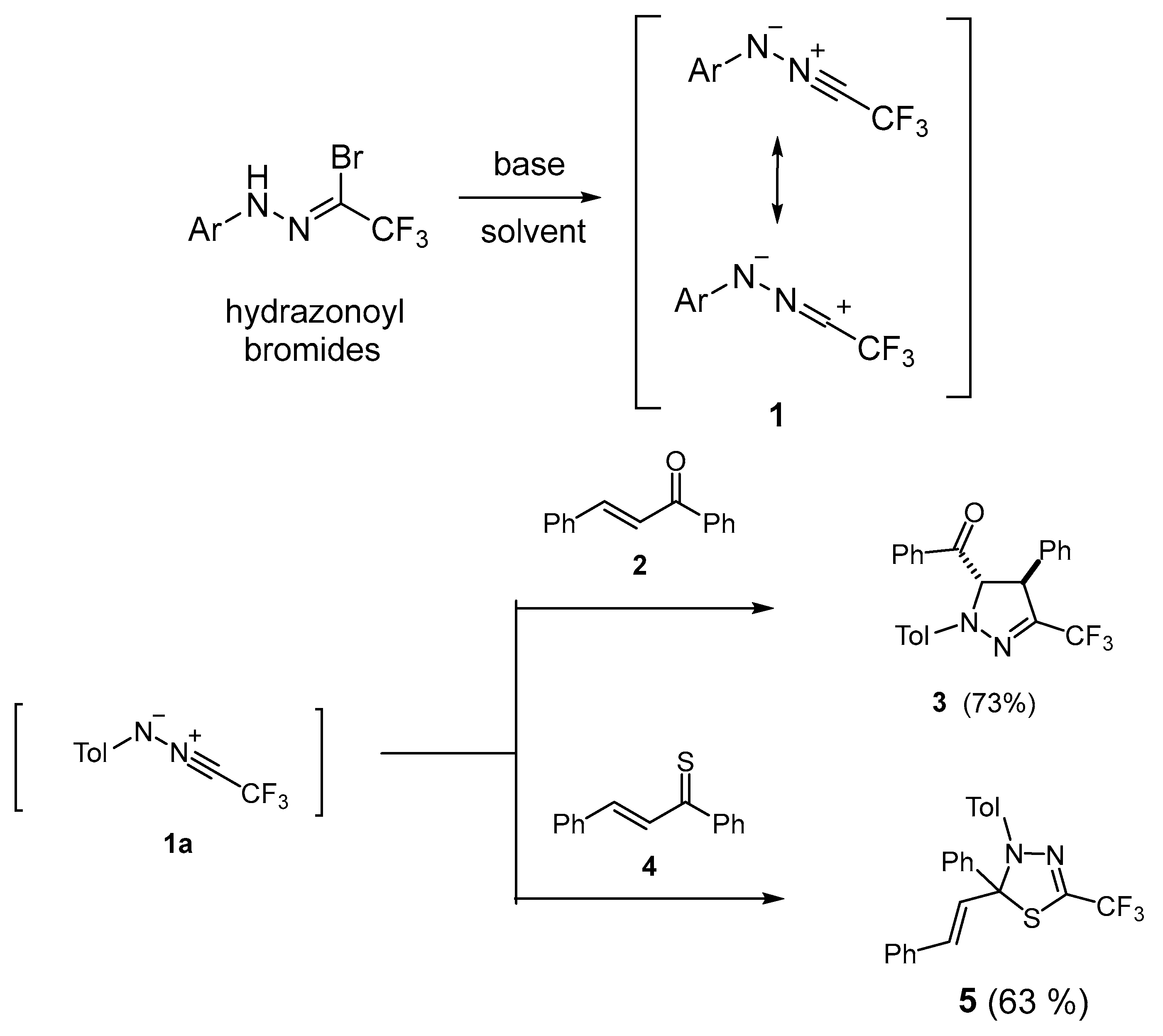

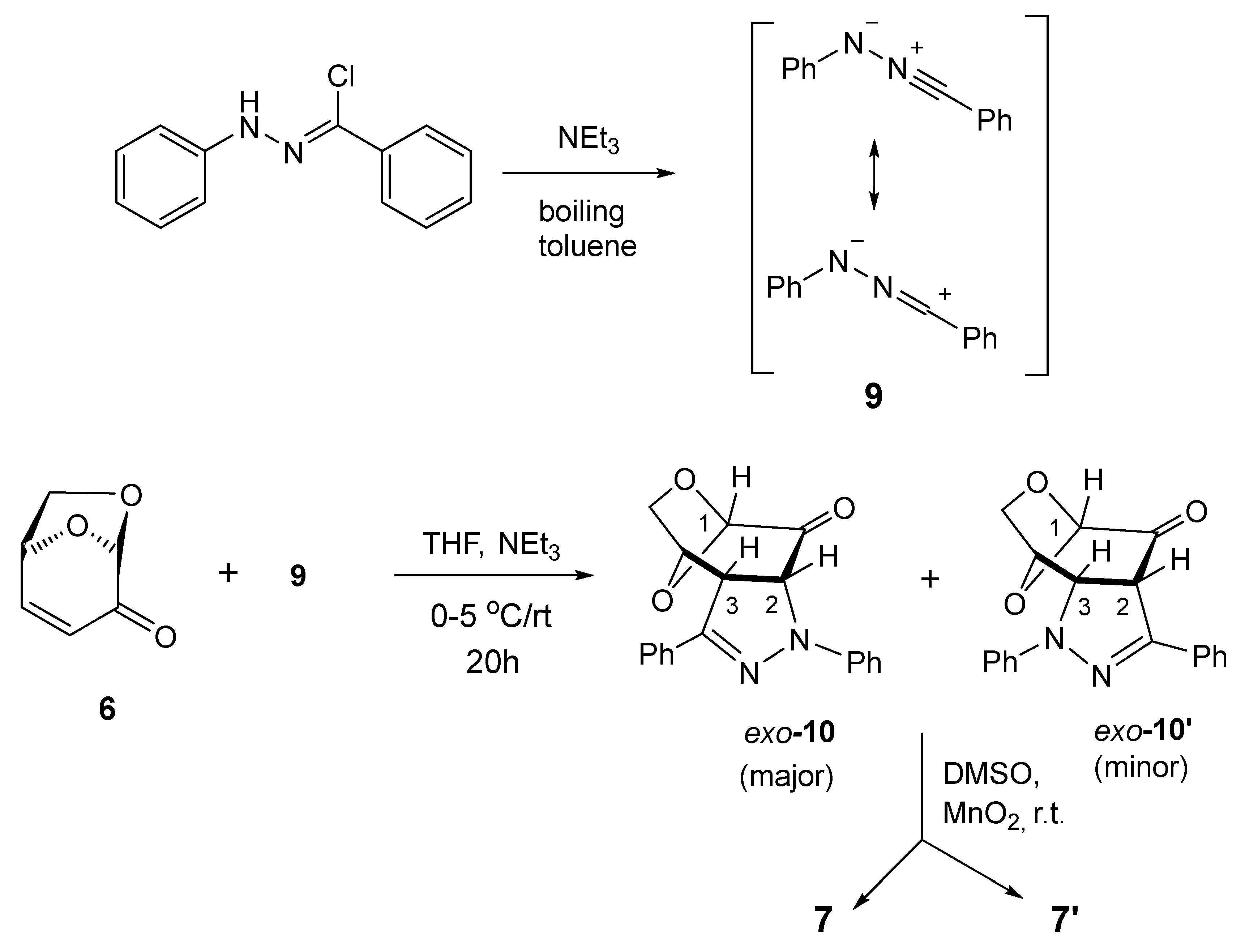

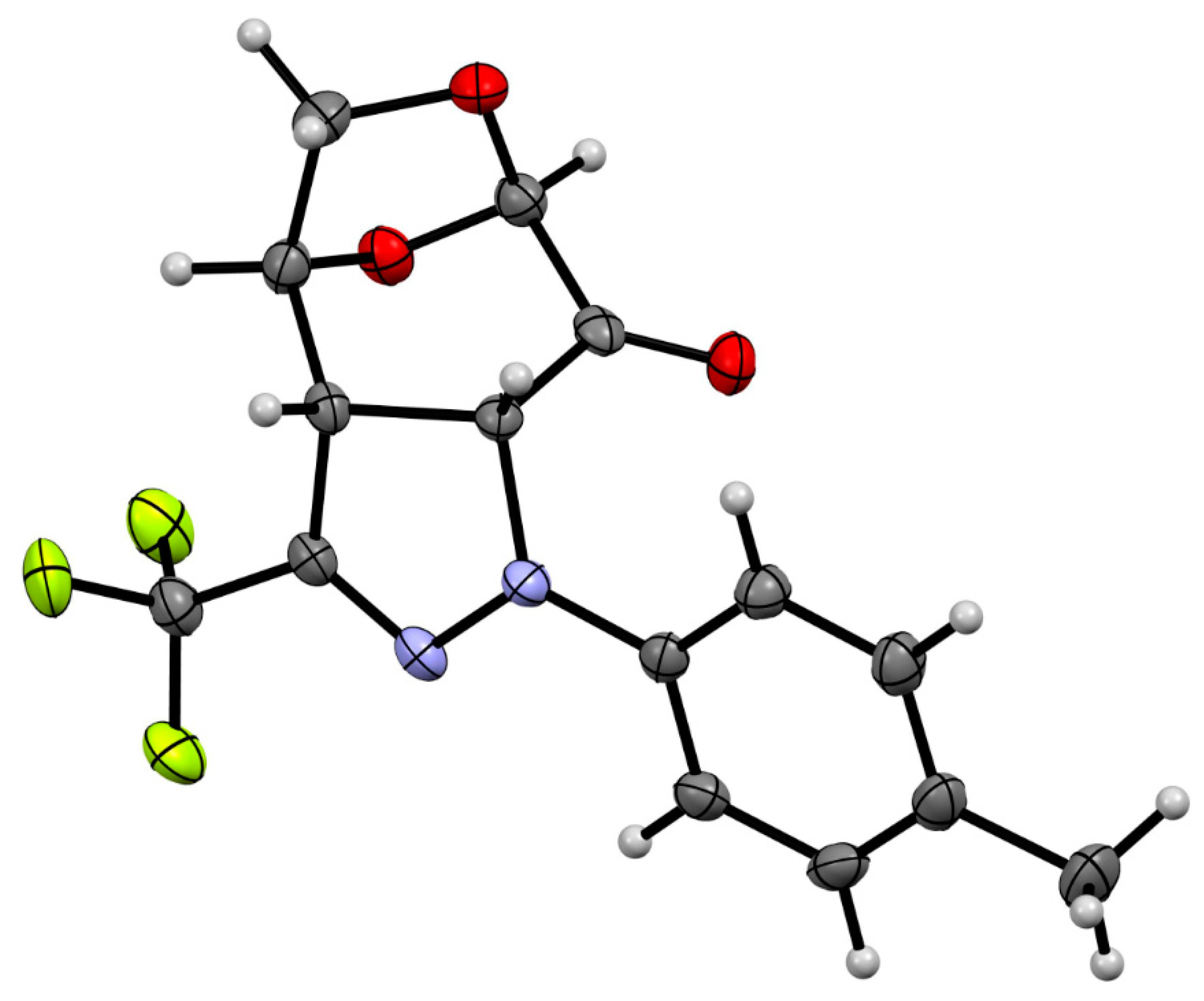
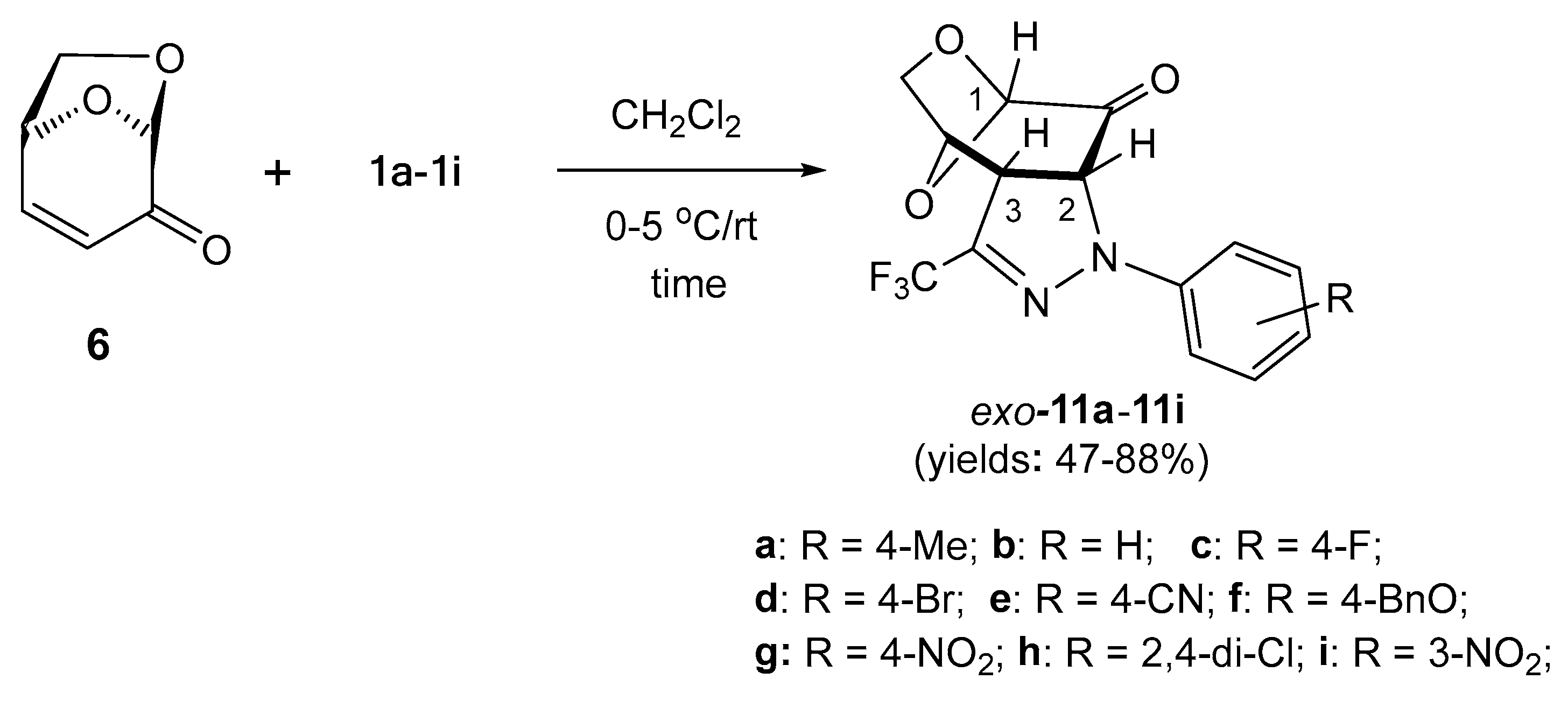
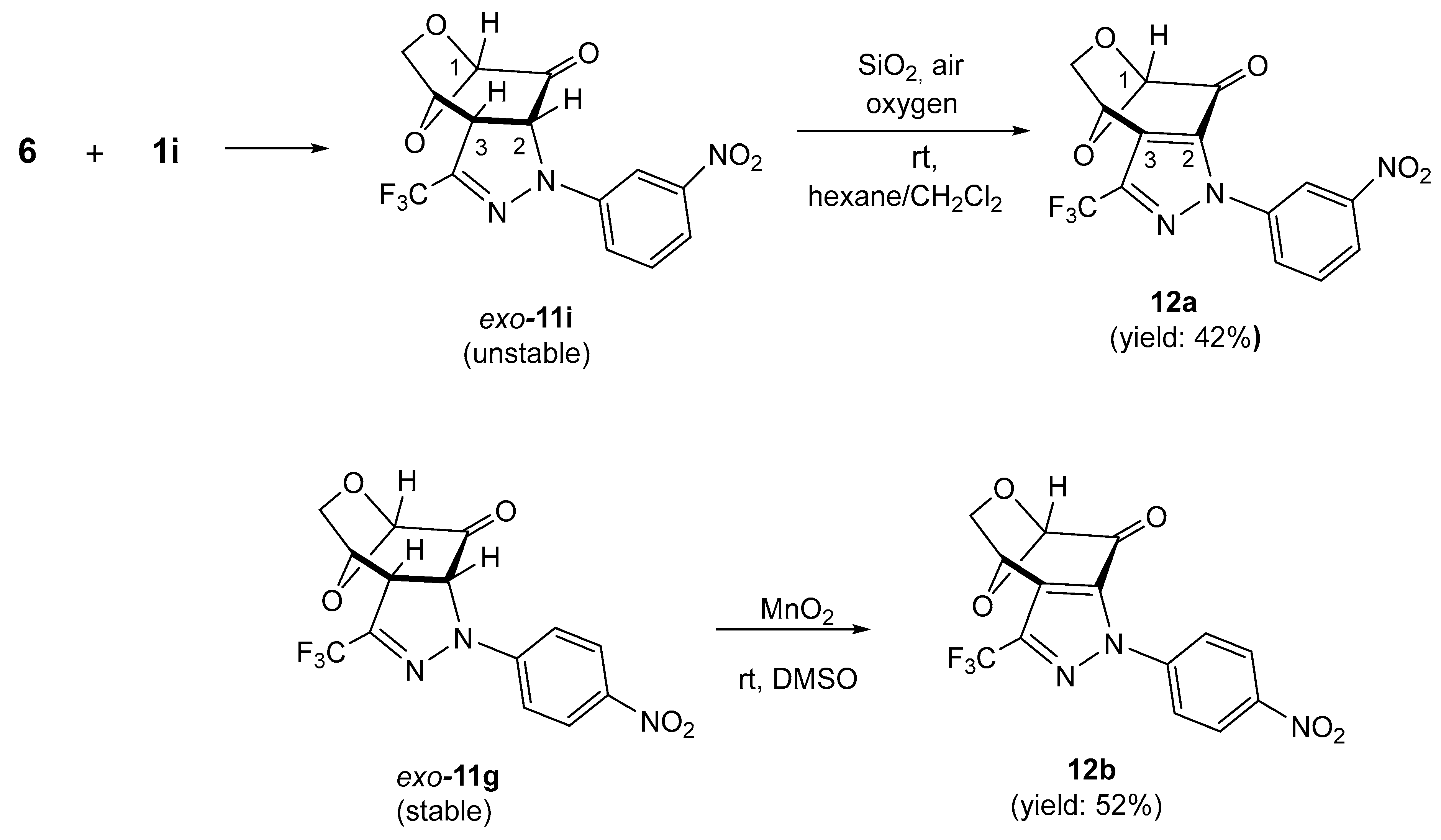


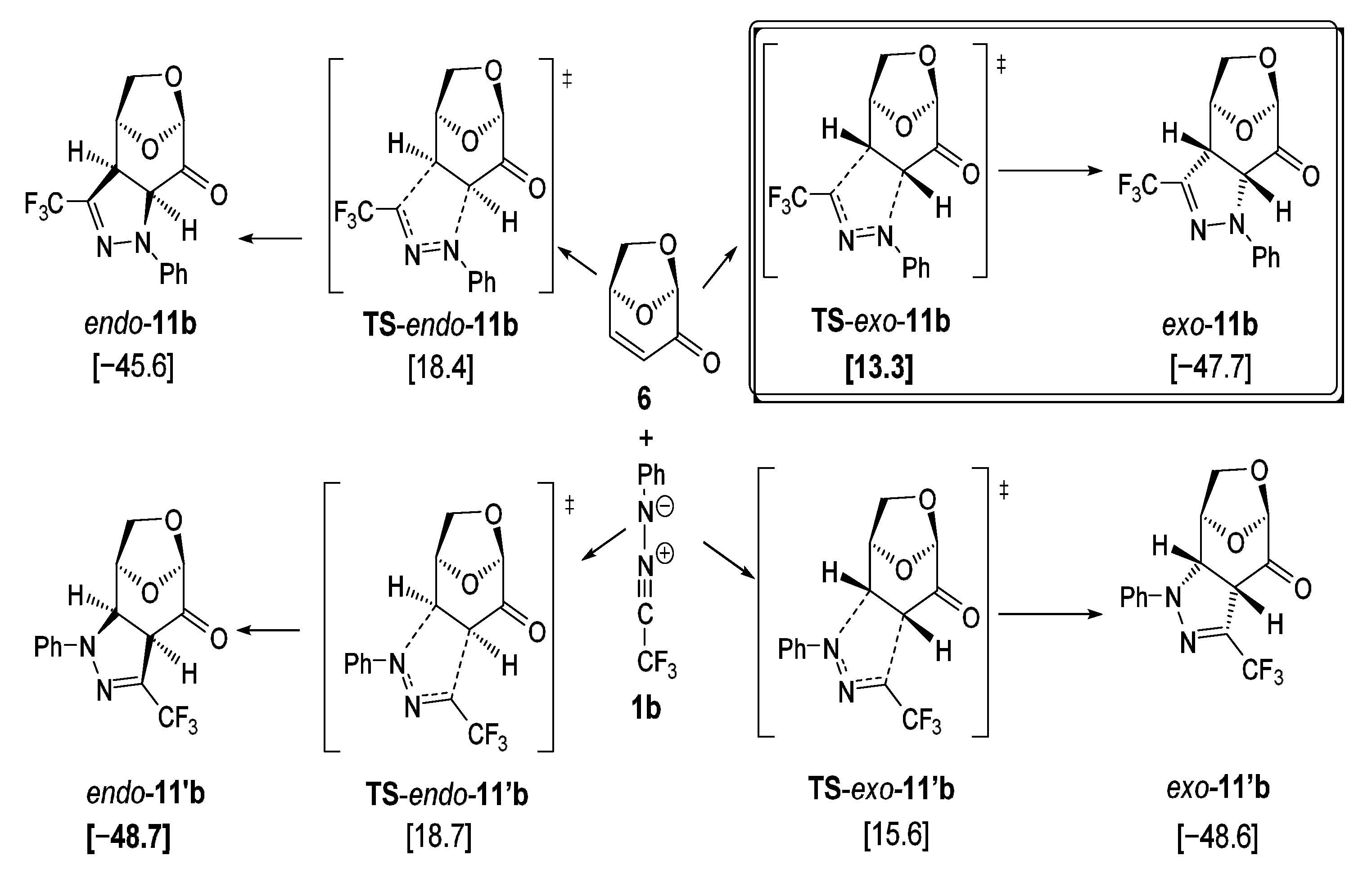

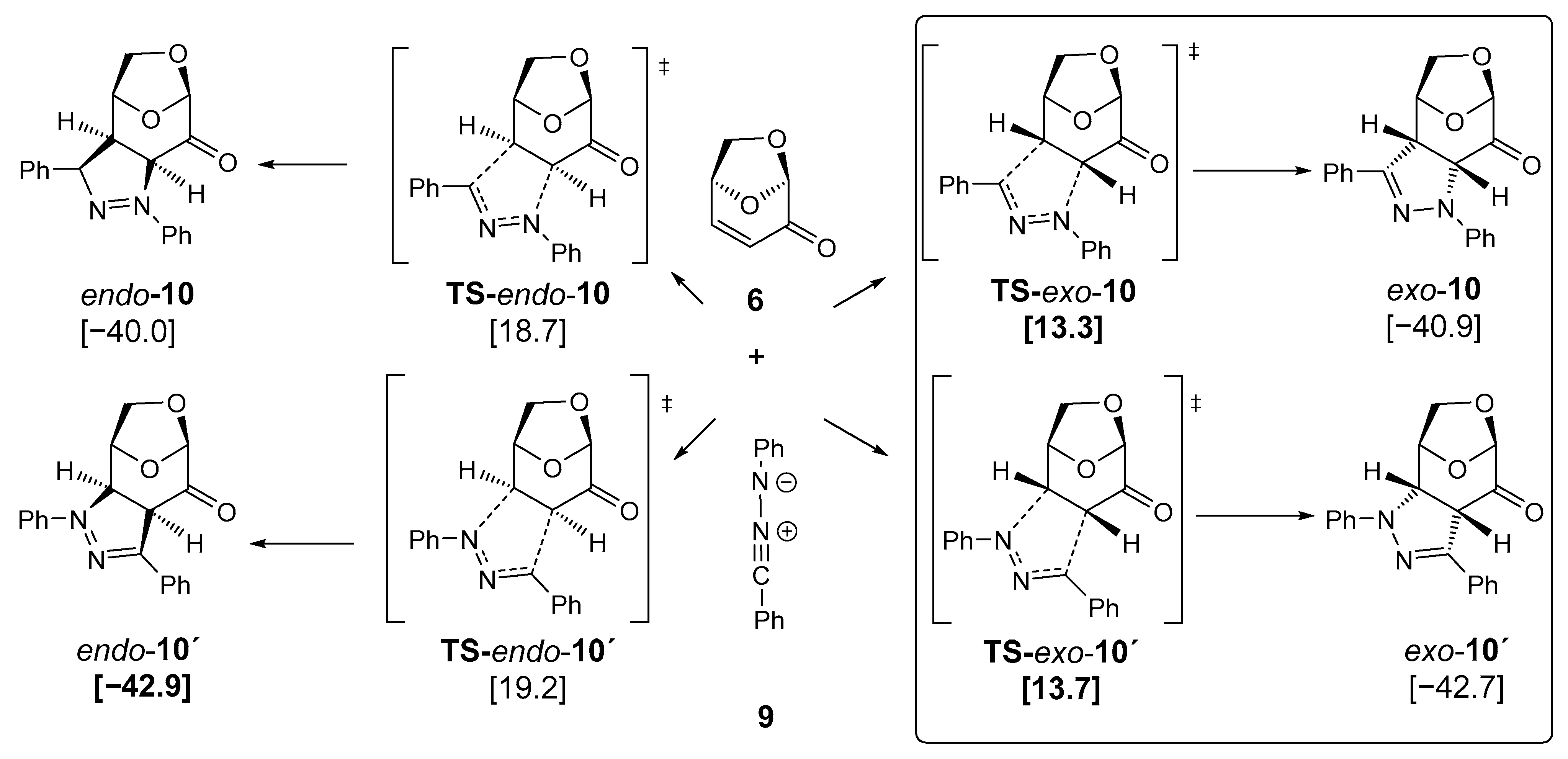
Disclaimer/Publisher’s Note: The statements, opinions and data contained in all publications are solely those of the individual author(s) and contributor(s) and not of MDPI and/or the editor(s). MDPI and/or the editor(s) disclaim responsibility for any injury to people or property resulting from any ideas, methods, instructions or products referred to in the content. |
© 2023 by the authors. Licensee MDPI, Basel, Switzerland. This article is an open access article distributed under the terms and conditions of the Creative Commons Attribution (CC BY) license (https://creativecommons.org/licenses/by/4.0/).
Share and Cite
Mlostoń, G.; Urbaniak, K.; Palusiak, M.; Witczak, Z.J.; Würthwein, E.-U. (3+2)-Cycloadditions of Levoglucosenone (LGO) with Fluorinated Nitrile Imines Derived from Trifluoroacetonitrile: An Experimental and Computational Study. Molecules 2023, 28, 7348. https://doi.org/10.3390/molecules28217348
Mlostoń G, Urbaniak K, Palusiak M, Witczak ZJ, Würthwein E-U. (3+2)-Cycloadditions of Levoglucosenone (LGO) with Fluorinated Nitrile Imines Derived from Trifluoroacetonitrile: An Experimental and Computational Study. Molecules. 2023; 28(21):7348. https://doi.org/10.3390/molecules28217348
Chicago/Turabian StyleMlostoń, Grzegorz, Katarzyna Urbaniak, Marcin Palusiak, Zbigniew J. Witczak, and Ernst-Ulrich Würthwein. 2023. "(3+2)-Cycloadditions of Levoglucosenone (LGO) with Fluorinated Nitrile Imines Derived from Trifluoroacetonitrile: An Experimental and Computational Study" Molecules 28, no. 21: 7348. https://doi.org/10.3390/molecules28217348
APA StyleMlostoń, G., Urbaniak, K., Palusiak, M., Witczak, Z. J., & Würthwein, E.-U. (2023). (3+2)-Cycloadditions of Levoglucosenone (LGO) with Fluorinated Nitrile Imines Derived from Trifluoroacetonitrile: An Experimental and Computational Study. Molecules, 28(21), 7348. https://doi.org/10.3390/molecules28217348






